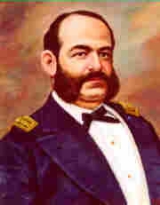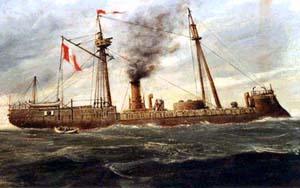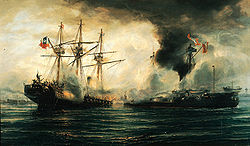
Miguel Grau Seminario
Encyclopedia
Miguel María Grau Seminario (Paita
, Peru
, 27 July 1834 – Punta Angamos, Bolivia
, 8 October 1879) was a renowned Peru
vian naval officer and hero of the Naval Battle of Angamos during the War of the Pacific
(1879-1884). He was known as the el Caballero de los Mares (Spanish for "Gentleman of the Seas") for his chivalry and is esteemed by both Peruvians and Chileans. He is an iconic figure for the Peruvian Navy, and one of the most famous merchant marine and naval military leaders of America.
, where he developed an outstanding professional reputation. In 1854, he was Military officer of the steamer Rimac. His career was rapid and brilliant. In 1863, he was promoted a year later. In 1864, he was sent to Europe to oversee the construction of ships for the Peruvian fleet. He would be put in prison a year later but was later released. Among these ships was the ironclad Huáscar
, launched in 1865 by Laird at Birkenhead
. Upon his return, Chile and Peru joined together in a bi-national fleet against Spanish attempts to reclaim their American colonies. In 1868, he was recalled to the Navy and was named commander of the Huáscar
with the rank of Lieutenant Commander and was later promoted to Commander. By June 1, 1874, he became the commanding officer of the Peruvian Navy's fleet as Captain, and later became a member of the Congress of the Republic of Peru as an elected congressman in 1876 representing Paita.
 When the War of the Pacific
When the War of the Pacific
against Chile
began on 5 April 1879, Miguel Grau was aboard the Huáscar
, as its captain and the Commander of the Navy. Capitán Grau played an important role by interdicting Chilean lines of communication and supply, damaging, capturing or destroying several enemy vessels, and bombarding port installations. Grau's Huáscar became famed for moving stealthily, striking by surprise and then disappearing. These actions put off a Chilean invasion by sea for six months.
 At the Battle of Iquique
At the Battle of Iquique
, after Huáscar sank the Chilean corvette Esmeralda by ramming her, Grau ordered the rescue of the surviving crew from the waters. Grau also wrote condolences to the widow of his opponent Arturo Prat
, returning his sword and personal effects.
Letter to Carmela Carvajal de Prat (Prat's widow)
At the port of Antofagasta
, after sneaking up on an enemy ship, he courteously asked the crew to abandon ship before opening fire. These and other gestures earned him the nickname of el Caballero de los Mares ("Gentleman of the Seas") from his Chilean opponents, acknowledging an extraordinary sense of chivalry and his gentlemanly behaviour, combined with his highly-efficient and brave combat career.
. His final resting place lies at the Escuela Militar Naval del Peru, in El Callao in an underground mausoleum. He posthumously received the rank of Gran Almirante del Perú (Grand Admiral
of Peru) in 1967 by order of the Peruvian Congress. A portrait of Almirante Grau is on display in the museum ship Huáscar.
Paita
Paita is a city in northwestern Peru. It is the capital of the Paita Province which is in the Piura Region. It is a leading seaport in that region...
, Peru
Peru
Peru , officially the Republic of Peru , is a country in western South America. It is bordered on the north by Ecuador and Colombia, on the east by Brazil, on the southeast by Bolivia, on the south by Chile, and on the west by the Pacific Ocean....
, 27 July 1834 – Punta Angamos, Bolivia
Bolivia
Bolivia officially known as Plurinational State of Bolivia , is a landlocked country in central South America. It is the poorest country in South America...
, 8 October 1879) was a renowned Peru
Peru
Peru , officially the Republic of Peru , is a country in western South America. It is bordered on the north by Ecuador and Colombia, on the east by Brazil, on the southeast by Bolivia, on the south by Chile, and on the west by the Pacific Ocean....
vian naval officer and hero of the Naval Battle of Angamos during the War of the Pacific
War of the Pacific
The War of the Pacific took place in western South America from 1879 through 1883. Chile fought against Bolivia and Peru. Despite cooperation among the three nations in the war against Spain, disputes soon arose over the mineral-rich Peruvian provinces of Tarapaca, Tacna, and Arica, and the...
(1879-1884). He was known as the el Caballero de los Mares (Spanish for "Gentleman of the Seas") for his chivalry and is esteemed by both Peruvians and Chileans. He is an iconic figure for the Peruvian Navy, and one of the most famous merchant marine and naval military leaders of America.
Early life
Miguel Grau was born in Paita on 27 July 1834 in the house of Dr. Alexander Diamont Newel with the assistance of the midwife Tadea Castillo, also known as "The Morito," both prominent figures in Paita. His father was Don Juan Manuel Grau y Berrío, a Colombian who came to Peru with Bolivar in the fight for independence from Spain. Later, Don Juan bought property in Paita and worked at the Customs Office. His mother, Luisa Seminario y del Castillo, motivated Grau to love the sea from his youth. He entered the Paita Nautical School. He first went to sea when he was nine years old, going to Fortune, Colombia, aboard a merchant schooner. The schooner sank and he returned to Paita. Grau later went on various merchant ships to ports in Oceania, Asia, America and Europe. These voyages gave Grau the seagoing experience that was the foundation for his brilliant career as a nautical officer.Early career
In 1853, at the age of 19, he left the merchant marine and became an officer candidate of the Peruvian NavyPeruvian Navy
The Peruvian Navy is the branch of the Peruvian Armed Forces tasked with surveillance, patrol and defense on lakes, rivers and the Pacific Ocean up to 200 nautical miles from the Peruvian littoral...
, where he developed an outstanding professional reputation. In 1854, he was Military officer of the steamer Rimac. His career was rapid and brilliant. In 1863, he was promoted a year later. In 1864, he was sent to Europe to oversee the construction of ships for the Peruvian fleet. He would be put in prison a year later but was later released. Among these ships was the ironclad Huáscar
Huáscar (ship)
Huáscar is a 19th century small armoured turret ship of a type similar to a monitor. She was built in Britain for Peru and played a significant role in the battle of Pacocha and the War of the Pacific against Chile before being captured and commissioned with the Chilean Navy. Today she is one of...
, launched in 1865 by Laird at Birkenhead
Birkenhead
Birkenhead is a town within the Metropolitan Borough of Wirral in Merseyside, England. It is on the Wirral Peninsula, along the west bank of the River Mersey, opposite the city of Liverpool...
. Upon his return, Chile and Peru joined together in a bi-national fleet against Spanish attempts to reclaim their American colonies. In 1868, he was recalled to the Navy and was named commander of the Huáscar
Huáscar (ship)
Huáscar is a 19th century small armoured turret ship of a type similar to a monitor. She was built in Britain for Peru and played a significant role in the battle of Pacocha and the War of the Pacific against Chile before being captured and commissioned with the Chilean Navy. Today she is one of...
with the rank of Lieutenant Commander and was later promoted to Commander. By June 1, 1874, he became the commanding officer of the Peruvian Navy's fleet as Captain, and later became a member of the Congress of the Republic of Peru as an elected congressman in 1876 representing Paita.
War of the Pacific

War of the Pacific
The War of the Pacific took place in western South America from 1879 through 1883. Chile fought against Bolivia and Peru. Despite cooperation among the three nations in the war against Spain, disputes soon arose over the mineral-rich Peruvian provinces of Tarapaca, Tacna, and Arica, and the...
against Chile
Chile
Chile ,officially the Republic of Chile , is a country in South America occupying a long, narrow coastal strip between the Andes mountains to the east and the Pacific Ocean to the west. It borders Peru to the north, Bolivia to the northeast, Argentina to the east, and the Drake Passage in the far...
began on 5 April 1879, Miguel Grau was aboard the Huáscar
Huáscar (ship)
Huáscar is a 19th century small armoured turret ship of a type similar to a monitor. She was built in Britain for Peru and played a significant role in the battle of Pacocha and the War of the Pacific against Chile before being captured and commissioned with the Chilean Navy. Today she is one of...
, as its captain and the Commander of the Navy. Capitán Grau played an important role by interdicting Chilean lines of communication and supply, damaging, capturing or destroying several enemy vessels, and bombarding port installations. Grau's Huáscar became famed for moving stealthily, striking by surprise and then disappearing. These actions put off a Chilean invasion by sea for six months.
The Gentleman of the Seas

Battle of Iquique
The Battle of Iquique was a confrontation that occurred on May 21, 1879, during the naval stage of the War of the Pacific, a conflict between Chile and Peru and Bolivia. The battle took place off the, by then, Peruvian port of Iquique...
, after Huáscar sank the Chilean corvette Esmeralda by ramming her, Grau ordered the rescue of the surviving crew from the waters. Grau also wrote condolences to the widow of his opponent Arturo Prat
Arturo Prat
Agustín Arturo Prat Chacón was a Chilean navy officer. He was killed shortly after boarding the Peruvian armored monitor Huáscar at the Naval Battle of Iquique after the ship under his command, the Esmeralda, was rammed by the Peruvian monitor...
, returning his sword and personal effects.
Letter to Carmela Carvajal de Prat (Prat's widow)
- Dear Madam:
- I have a sacred duty that authorizes me to write you, despite knowing that this letter will deepen your profound pain, by reminding you of recent battles.
- During the naval combat that took place in the waters of Iquique, between the Chilean and Peruvian ships, on the 21st day of the last month, your worthy and valiant husband Captain Mr. Arturo Prat, Commander of the Esmeralda, was, like you would not ignore any longer, victim of his reckless valor in defense and glory of his country’s flag.
- While sincerely deploring this unfortunate event and sharing your sorrow, I comply with the sad duty of sending you some of his belongings, invaluable for you, which I list at the end of this letter. Undoubtedly, they will serve of small consolation in the middle of your misfortune, and I have hurried in remitting them to you.
- Reiterating my feelings of condolence, I take the opportunity of offering you my services, considerations and respects and I render myself at your disposal.
- (Signed) Cpt. Miguel Grau
At the port of Antofagasta
Antofagasta
Antofagasta is a port city in northern Chile, about north of Santiago. It is the capital of Antofagasta Province and Antofagasta Region. According to the 2002 census, the city has a population of 296,905...
, after sneaking up on an enemy ship, he courteously asked the crew to abandon ship before opening fire. These and other gestures earned him the nickname of el Caballero de los Mares ("Gentleman of the Seas") from his Chilean opponents, acknowledging an extraordinary sense of chivalry and his gentlemanly behaviour, combined with his highly-efficient and brave combat career.
Death at Battle of Angamos
Almirante Grau was killed by an armor-piercing shell during the Naval Battle of Angamos on 8 October 1879. Huáscar was captured by the Chileans after incurring severe casualties in the close-range artillery duel. Although most of Grau's body was not recovered, his remains were buried with military honours in Chile, which were returned to Peru in 1958. For many years after his death, his name was called in a ceremonial roll-call of the Peruvian NavyPeruvian Navy
The Peruvian Navy is the branch of the Peruvian Armed Forces tasked with surveillance, patrol and defense on lakes, rivers and the Pacific Ocean up to 200 nautical miles from the Peruvian littoral...
. His final resting place lies at the Escuela Militar Naval del Peru, in El Callao in an underground mausoleum. He posthumously received the rank of Gran Almirante del Perú (Grand Admiral
Grand Admiral
Grand admiral is a historic naval rank, generally being the highest such rank present in any particular country. Its most notable use was in Germany — the German word is Großadmiral.-France:...
of Peru) in 1967 by order of the Peruvian Congress. A portrait of Almirante Grau is on display in the museum ship Huáscar.

